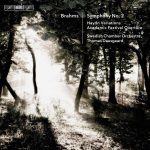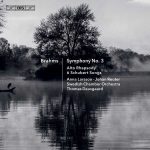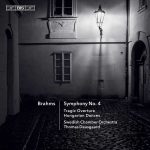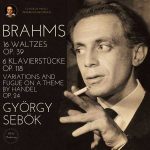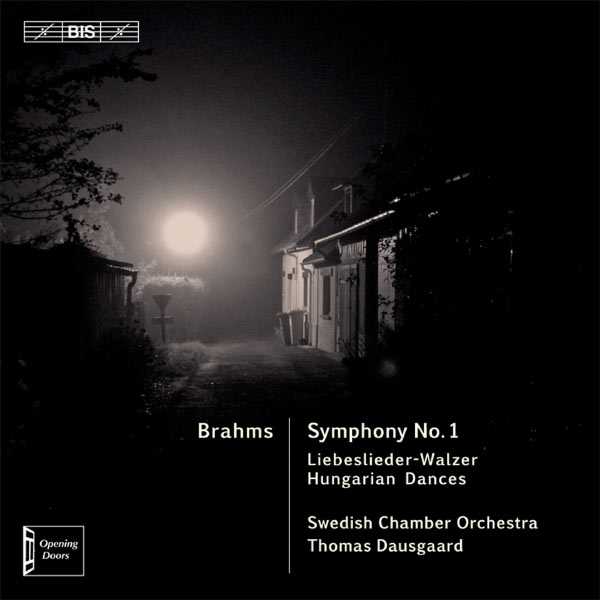

Composer: Johannes Brahms
Orchestra: Swedish Chamber Orchestra
Conductor: Thomas Dausgaard
Format: FLAC (tracks)
Label: BIS
Catalogue: BIS1756
Release: 2013
Size: 580 MB
Recovery: +3%
Scan: yes
Symphony No. 1 in C minor, Op. 68
01. I. Un poco sostenuto – Allegro
02. II. Andante sostenuto
03. III. Un poco allegretto e grazioso
04. IV. Adagio – Piu andante – Allegro non troppo ma con brio
18 Liebeslieder Waltzes, Op. 52 (version for orchestra) (arr. W. Weismann)
05. No. 1, Rede, Madchen
06. No. 2, Am Gesteine rauscht die Flut
07. No. 4, Wie des Abends schone Rote
08. No. 6, Ein kleiner, hubscher Vogel
09. No. 5, Die grune Hopfenranke
10. 15 Neue Liebeslieder Waltzes, Op. 65: No. 9, Nagen am Herzen (version for orchestra) [arr. W. Weismann]
18 Liebeslieder Waltzes, Op. 52 (version for orchestra) (arr. W. Weismann)
11. No. 11, Nein, es ist nicht auszukommen
12. No. 8, Wenn so lind dein Auge
13. No. 9, Am Donaustrande
21 Hungarian Dances, WoO 1 (orch. J. Brahms)
14. Hungarian Dance No. 1 in G Minor
15. Hungarian Dance No. 3 in F Major
16. Hungarian Dance No. 10 in E Major
A weighty symphony, swaying Viennese waltzes and fiery Hungarian dances make up the colourful programme when Thomas Dausgaard and his Swedish Chamber Orchestra engage with Johannes Brahms in Opening Doors, the team’s acclaimed series of Romantic orchestral composers. Johannes Brahms was only twenty years old when Robert Schumann hailed him as one whose genius gave rise to the greatest symphonic hopes. It is therefore striking that he didn’t complete his First Symphony until more than twenty years later, in 1876 – even though the earliest sketches for it date back to 1855. Brahms – who once said that he constantly heard the ‘giant’ Beethoven ‘marching behind him’ – had such a deep respect for what his great predecessor had achieved with the genre that he for a long time doubted that he would ever be able to write a symphony of his own – by the time he did, it must have been gratifying to him that it was hailed as ‘Beethoven’s Tenth’. While working on the symphony, Brahms composed his Op.52, the cycle Liebeslieder-Walzer ‘for piano four-hands (and song ad libitum)’. He kept the forces as flexible as possible: the waltzes were performable with or without voices; if used, the vocal parts could be sung either by soloists or by a choir. Even so, he was soon asked for another version, for choir and orchestra. Brahms initially rejected this idea, but finally agreed to make a partial orchestration: selecting eight of the Op.52 waltzes, he supplemented them with an early version of one of the not yet published Neue Liebeslieder-Walzer, Op.65. Around the same time, he was asked to orchestrate another collection of dances composed for piano four-hands: his first set of Hungarian Dances, which had quickly become a great hit. It took him four years to comply with this wish, and even then he only accepted to orchestrate three of the dances, leaving the field open for various other arrangers (including Dvořák) to satisfy the demand for more.
Here’s a Brahms Symphony No. 1 in C minor, Op. 68, of the revisionist sort. Swedish conductor Thomas Dausgaard and the Swedish Chamber Orchestra, of which he is music director, have embarked on an “Opening Doors” series aimed at bringing new audiences to Romantic repertory. The live performances are informal (the musicians have been known to wear sandals), and the recordings are brisk, direct, modest in size, and sometimes oriented toward historical performance techniques. The three dozen-plus players of the Swedish Chamber Orchestra are probably equivalent in number to those who played the work at its Karlsruhe premiere in 1876, although even in Brahms’ day the trend was toward larger forces. The unconventional quality lies not in the size of the orchestra but in the phrasing and the overall mood, which largely strips out the warmth and sentiment in favor of a clarity of texture that worked quite well in Dausgaard’s recordings of Schumann’s problematical symphonies. Here, with the entire symphony coming in at under 45 minutes (up to an hour is common), you may miss some cherished moments, and the thoroughgoing reduction in vibrato tends to keep a sharp edge on things. On the other hand, Dausgaard will probably show you a few details in the counterpoint that you had missed, and the run-up to the famed theme in the symphony’s finale is very nicely controlled. In the Liebeslieder Waltzes and Hungarian dances that round out the album, there is really no need for Dausgaard’s minimal approach, but in the Symphony No. 1 it’s worth considering, even if it’s not a great choice for a first exposure to the work. BIS’ Super Audio sound is a major plus.
